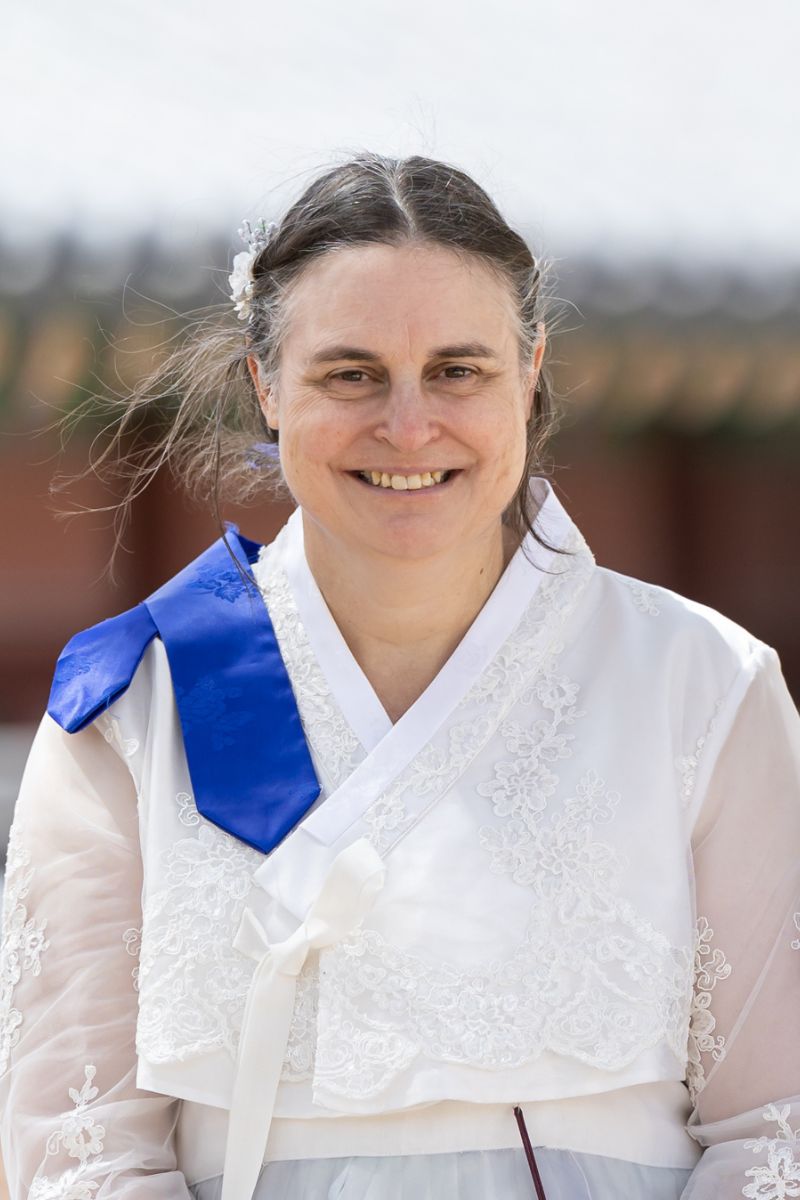A popular question for visitors is what are the best things to do in Gyeongju. The aim of this article is to help you learn more about the most popular Gyeongju attractions for tourists to help you plan your visit.
Plan to stay in Gyeongju for at least two days to make the most of your visit, and preferably longer if possible. Gyeongju is easy to get to from Seoul – the fast trains make the journey to Singyeongju Station in just over two hours, and from there you can take a bus for 30 minutes to reach the centre of Gyeongju.
There are also many inter city and express bus options which travel direct to the center of Gyeongju. Click here to book your Express Bus ticket from Seoul to Gyeongju through Trazy.
From Busan it is a bus journey of only one hour, so you could also visit as a day trip or day tour from Busan.
Gyeongju is easy to get around on the local bus system, but in our experience you will get a lot more value by of taking a guided tour to learn more about each attraction that you visit. Therefore, as you go through our article below we have also recommended coach, small group and private tour options which will enable you to fully experience each attraction.
These tours can be easily booked through Klook, Trazy and Get Your Guide, who are our recommended online travel agents for South Korea. They have a good reputation and we have worked with each of them for many years now, so have high confidence that they will enable you to have a great experience!
Don’t miss out on the opportunity to make your trip planning easy, hassle-free and organized. Click here to download your FREE printable checklist, to help you to plan your trip step by step and tick off items as you finalise your preparations.Join the South Korea Travel Planning Facebook Group
You are also welcome to join our South Korea Travel Planning Facebook Group – it is a great resource to enable you to ask questions about your upcoming trip to South Korea!
Disclaimer: This article contains affiliate links. If you book after clicking on one of these links then we may receive a small commission at no extra cost to you.
About Gyeongju
Gyeongju, which is known as ‘the museum without walls’, was the capital city of the ancient Silla Kingdom, which ruled over a large part of the Korean Peninsula for 1000 years, roughly from 57BC to 935AD. As a result there are a large number of historical sights, with many UNESCO World Heritage Sites, along with many Josean era attractions. Gyeongju is located north of Busan in the south east of South Korea.
Tourist Map of Gyeongju
To help you better understand where each tourist attraction is located in Gyeongju we have put together a detailed map below. You can zoom in and out and click on each attraction to see more details without leaving this page. In red are the major transportation hubs so you can more easily see where things are in relation to those key points. Check out our detailed article on how to get around Gyeongju to help you plan your visit.
Gyeongju Tours
There are many Gyeongju day tour and experience options available through Trazy as detailed below:
- The Gyeongju 1 Day Bus Tour enables you to more easily visit the major attractions. There are three courses, which each run on different days with pick ups and drop offs from local hotels, the Express Bus Terminal and the Singyeongju KTX Station. Note that entrance fees are not included in the tour cost, and this tour is transport only, with a Korean tour guide (no English). Click here to check out and book these tours through Trazy.
- The Gyeongju Private Taxi Tour is a great option for small groups of up to 4 people to visit Gyeongju with a personalised itinerary and a driver with basic English. You will be picked up and dropped off at either your hotel, Express Bus Terminal or the Singyeongju KTX Station. Note that entrance fees are not included. Click here to check out and book this tour through Trazy.
- The Gyeongju Private One Day Tour is a great option for groups of up to 7 people to visit Gyeongju, either locally or from Busan, with a personalised itinerary and a driver with excellent English. You will be picked up and dropped off at either your Gyeongju or Busan hotel, Gyeongju Express Bus Terminal or the Singyeongju KTX Station. Note that entrance fees are not included. Click here to check out and book this tour through Trazy.
Gyeongju Tours from Busan
To visit Gyeongju as a day trip from Busan, the best option is to book a one day tour to make the most of your visit. There are several day tour options available through Klook as follows:
- Visit Yangdong Village, Anapji Pond, Bulguksa Temple and the Seokguram Grotto. This tour is available on Thursday each week. Pick up and drop off from KTX Busan Station, Seomyeon Station and Haeundae Station. Click here to check out and book this tour through Klook.
- Visit Cheomseongdae Observatory, Daereungwon Tomb Complex, Hwanglidan Street, Gyochon Traditional Village, Woljeong Bridge, Bulguksa Temple and Night view of Anapji Pond. This small group tour is available on Tuesday and Friday each week. Pick up and drop off from Seomyeon Station or Ulsan KTX Station. Click here to check out and book this tour through Klook.
- Visit Bulguksa Temple, Seokguram Grotto, Anapji Pond, Cheomseongdae Observatory, Gyeongju National Museum, Cheonmachong Tomb and Yangdong Folk Village. This private tour (up to 8 passengers) is available every day and will pick up and drop off at your Busan hotel. Click here to check out and book this tour through Klook.
Major Events in Gyeongju
The major events in Gyeongju each year include the following (note many events were cancelled due to COVID19 are currently in the process of being re-established):
- Gyeongju Cherry Blossom Festival – early April
- Gyeongju Silla Ceramics Festival – late April
- Gyeongju International Music Festival – July/August
- Silla Cultural Festival – October
- Choongdamjae Tea Festival – October
- Watch Night Bell Tolling Ceremony – New Years Eve
- Haeryong Sunrise Festival – New Years Eve and New Years Day
Things to Do in Gyeongju
The Gyeongju Historic Area is easily accessible central area where the main attractions are easily walkable. You can easily spend a whole day exploring this area. There are additional attractions around Gyeongju where you will need to travel further on a bus, however they are also well worth it! Below we have detailed the main attractions to help you plan your visit.
While you are exploring Gyeongju, make sure you try the local food specialties, which include ssambap (meat, rice, sauces and side dishes which you wrap with green leaves) and Hwangnam bread (a pastry with a red bean paste filling).
Where to Stay in Gyeongju
There are several main options for areas to stay in Gyeongju as follows:
- The area north from the Express Bus Terminal is a great affordable option within easy walking distance to the main Gyeongju Historic Area and also has a great selection of food options available. Click here to check out and book your Gyeongju accommodation through Booking.com.
- In the popular Hwangridan-gil area, which is located east from the Express Bus terminal and is a great place to stay in a traditional hanok house, with many great food options in the area. This is a great area but is more expensive. We stayed here ourselves at Trip from Gyeongju, which is a great mid level hanok style accommodation option with easy access to the local attractions. Our friendly host provided us a with a map and recommendations for local restaurants. They have family rooms able to accommodate up to 8 people with a combination of western style and Korean style bedding. Amenities include a garden and free Wifi. Click here to check it out and book through Booking.com.
- In the area around Gyeongju World Theme Park is the only five star hotel in Gyeongju, plus many other options. You can get here easily by bus, a trip of 35 minutes east from the Express Bus Terminal. Click here to check out and book your Gyeongju accommodation through Booking.com.
- Do a TempleStay at Golgulsa Temple, one of the most popular TempleStays in South Korea. You can experience traditional rituals, meditation and martial arts training. Golgulsa Temple is easy to access from the Gyeongju Express Bus Terminal, a trip of approximately 50 minutes south east, followed by a 15 minute walk.
Gyeongju Historic Area
The central Gyeongju Historic Area spreads across approximately 2km / 1.3 mi, so is easily walkable and is also accessible by bus. Another option to get around the area is to rent a bicycle, electric scooter or gas scooter (International Drivers Permit required) which can be collected and returned from near the Gyeongju Express Bus Terminal. You can prebook your bike or scooter rental option through Trazy at this link.
National Museum of Gyeongju
The National Museum of Gyeongju is a great first place to visit in Gyeongju to learn more about the Silla Kingdom before exploring the historic area. Permanent exhibits include the Silla History Gallery, Silla Art Gallery, Wolji Gallery and the Outdoor Exhibition Area, including the Divine Bell of King Seodeok. Plan to spend 2-3 hours exploring the museum. The museum is open most days of the year from 10am to 6pm, closing at 7pm on weekends and holidays.
Wolseong Palace
Wolseong Palace (or Banwolseong Fortress) was the main Silla dynasty palace which commenced construction in 101 AD. Its name means ‘a crescent moon shape on top of a hill’, and the palace was in place for around 900 years. These days the location of the palace is an empty field on a hill which is located in the Gyeongju Historic Area, bounded by the Namcheongang River to the south.
Since 2014 archeologists have been excavating the 50 acre site of Wolseong Palace, during which many artifacts have been found so far. The most notable discovery so far were three bodies in 2017 and 2021, buried as ritual sacrifices. There is an observation deck where you can observe the excavations.
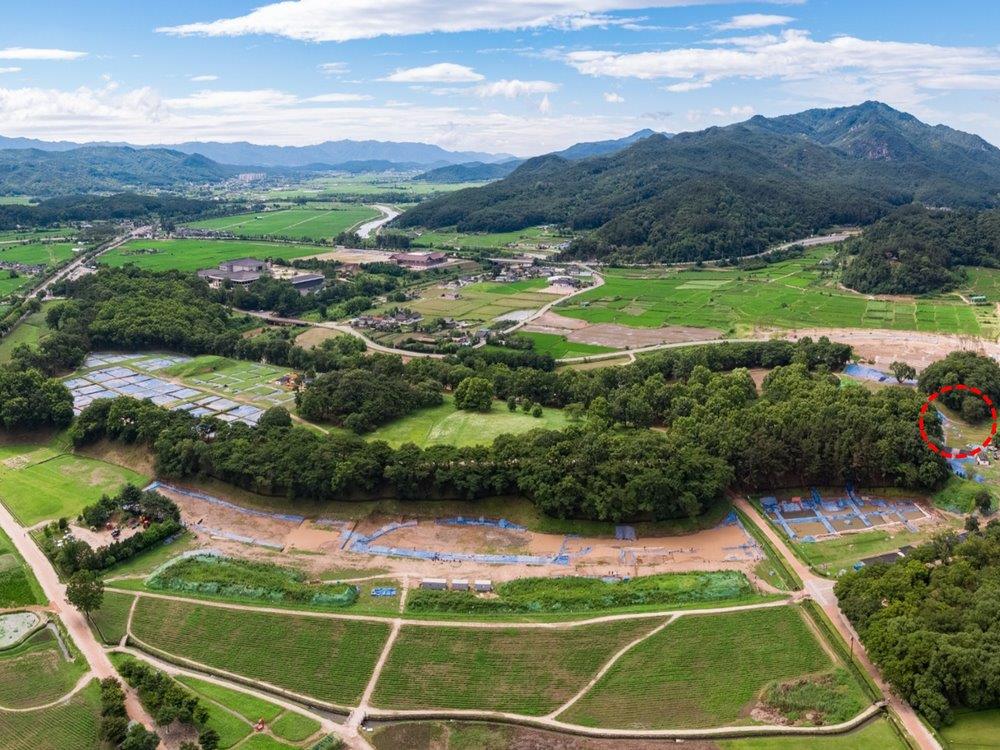
Seokbinggo Stone Ice Storage
The main attraction at the Wolseong Palace site for tourists is Seokbinggo, an ancient Korean stone ice storage room which enabled ice to be available in the middle of summer. You can view the room from the front gate and experience the coolness of the breeze as a result of the clever construction and ventilation system. There are only seven Seokbinggo remaining in Korea today, and this one was relocated to Gyeongju in 1742, during the Josean Dynasty.
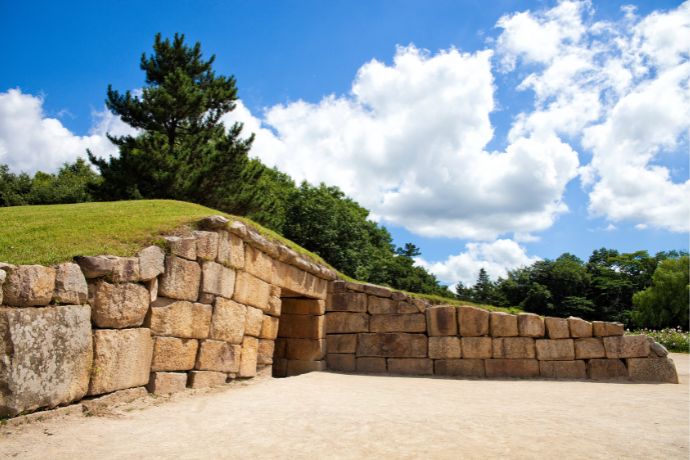
Daereungwon Tomb Complex in Tumuli Park
A must visit location in the Gyeongju Historic Area is Royal Tumuli Park. There are more than twenty distinctive tomb mounds within the park, of which 13 have been excavated and one is open to the public to visit. Note that you are not allowed to climb the mounds. Tumuli Park is open from 9am – 10pm daily. Plan to spend 1-2 hours exploring the park.
The Silla Kingdom era tomb mounds have been built with a wooden coffin in the center, which has then been covered in mounds of rock which are sealed with clay, and then a final layer of dirt over the top of the mound. The larger tomb mounds are where royalty have been buried inside a wood lined chamber. There are also a lot of smaller burial mounds for lesser folk and commoners.
Great Hwangnam Tomb in Tumuli Park
The largest tomb is the Great Hwangnam Tomb, which is a double mound. It has two high points of 22.6m high at the northern peak and 21.9m high at the southern peak. The double tomb is 120m across from north to south and 80m west to east. The Great Hwangnam Tomb contained the remains of both a king and queen (unidentified) along with over 57,000 artefacts, including a golden crown and belt, jewelry, weapons and horse riding equipment. These items are on display at the National Museum of Gyeongju.
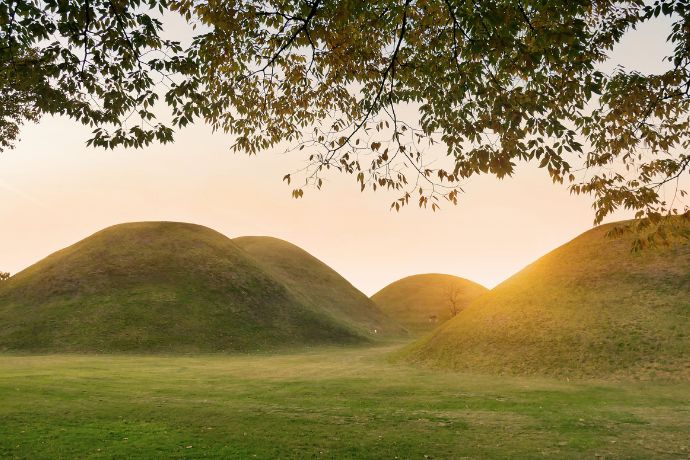
Cheonmachong Ancient Tomb in Tumuli Park
The Cheonmachong Ancient Tomb is only tomb open for visitors, with replica artefacts on display in their original location. This tomb is named the ‘Heavenly Horse Tomb’ as a result of the discovery during excavation of a mural of the Heavenly Horses of the Jade Emperor on the inside chamber wall. The original artefacts are on display at the National Museum of Gyeongju.
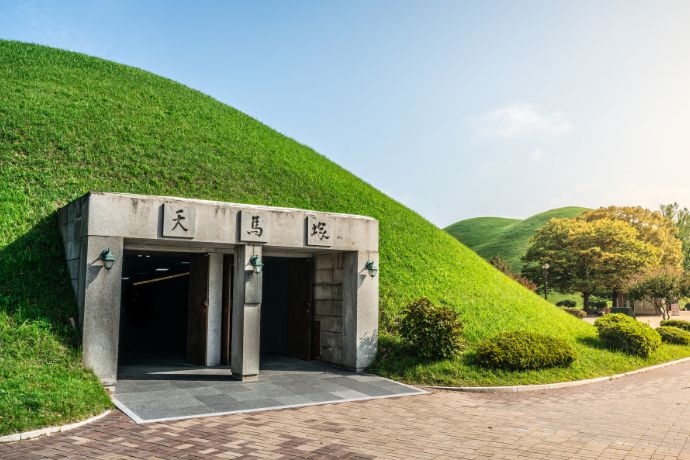
Cheomseongdae Observatory
Cheomseongdae Observatory is a must see attraction in Gyeongju. Located in the center of the Gyeongju Historic Area, it is great to visit both by day and night and contemplate the oldest astronomical observatory in east Asia. Cheomseongdae Observatory was built in the mid 600’s and is 9m / 30ft tall and 5m / 16ft wide.
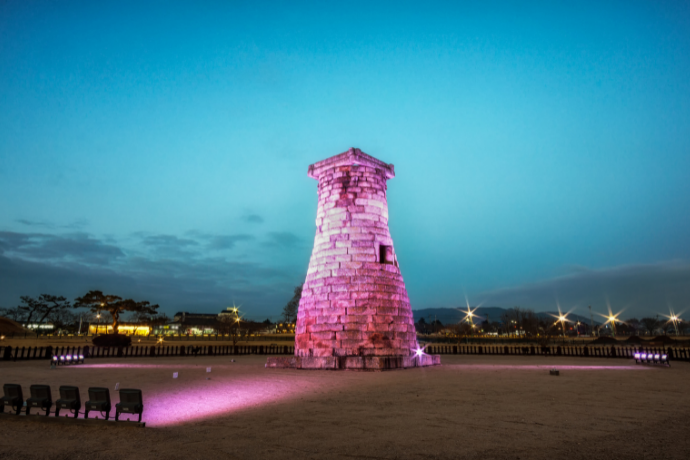
Donggung Palace & Wolji Pond
Donggung Palace & Wolji Pond is another must visit attraction in Gyeongju to appreciate the magnitude of the palace complex which was subsequently burnt down and never reconstructed. Donggung Palace & Wolji Pond is open from 9am – 10pm daily. Plan to spend 1-2 hours exploring the park, and make sure you plan to visit at night to see the beautiful illuminations.
Donggung Palace was used as the palace where the Silla princes lived. It was known as the place to go for parties, meetings and for guests to visit. These days you can see the palace ruins onsite, as well as some reconstructed structures.
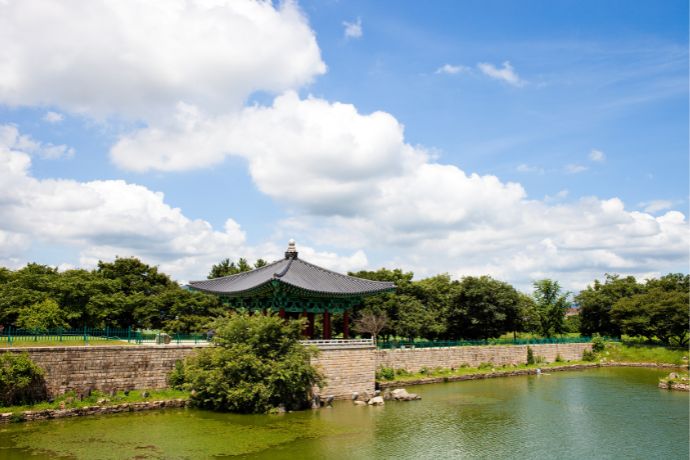
Outside the ruins of Donggung Palace you can find Wolji Pond, which was the centerpiece of the amazing garden which existed in the late 600’s. The pond is man made, with three islands inside the pond. For many years this pond was known as Anapji Pond (the duck/goose pond), however when excavations were undertaken in the 1970’s and 1980’s a pottery fragment was found indicated that the correct name of the pond was Wolji Pond, a pond which reflects the moon. The pond was subsequently renamed to Wolji Pond.
The excavation of Donggung Palace & Wolji Pond is still in progress. You can see many of the relics which have been found at the Wolji Hall inside the National Museum of Gyeongju, which includes a miniature representation of the palace complex.
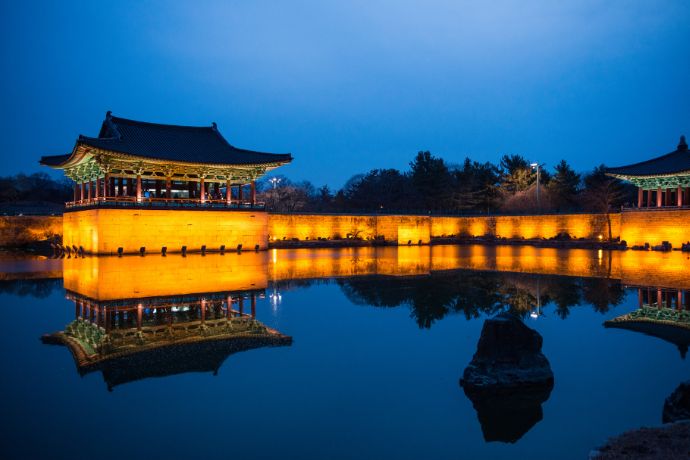
Gyochon Traditional Village
Gyochon Traditional Village (Gyeongju Hyanggyo) is a great option to get a sense of what it was like to live in Gyeongju during the Silla period, with traditional crafts and foods to experience. Experiences include:
- Crockery Workshop / Kiln
- Quilt-Making Center
- Mi-Gyeong Traditional Culture Center
- Gyochon Gugak Performance Hall
A great experience is to participate in a Korean Traditional Sauce Making Experience at Gyochon Village. In this short experience you will learn how to make either Gochujang, Doenjang or Bibimap, which you can either eat or take with you. Click here to check out and book this experience through Trazy.
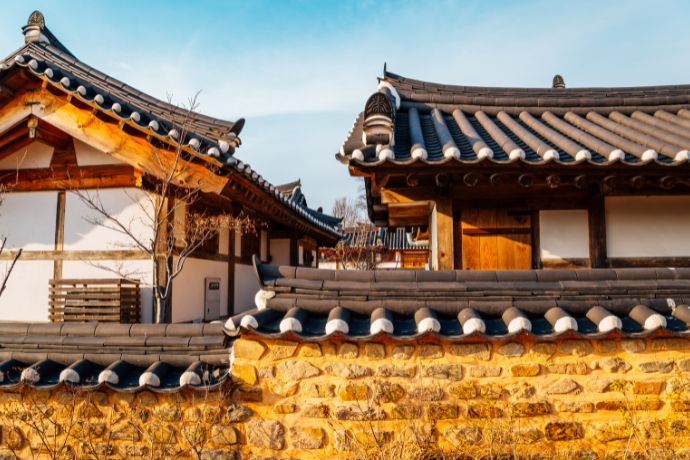
Woljeonggyo Bridge
Woljeonggyo Bridge is a wooden bridge which was originally built during the Silla Dynasty in approximately 760 AD, however was burned down during the Josean Dynasty. Woljeonggyo Bridge was reconstructed over 2008-2018, and is now a great sight both during the daytime and when illuminated during the night, so is well worth a visit. In the gatehouse there is an exhibit where you can learn more about the reconstruction process.

Hwangridan-gil
Hwangridan-gil is the north-south road located to the west of Daereungwon Tomb Complex, with easy access by bus or by walking from the Intercity and Express Bus depots. Hwangridan-gil is the local hotspot for accommodation, restaurants, cafes and more – and has a distinct hanok building vibe, noting that most of these hanok style buildings are newly constructed.
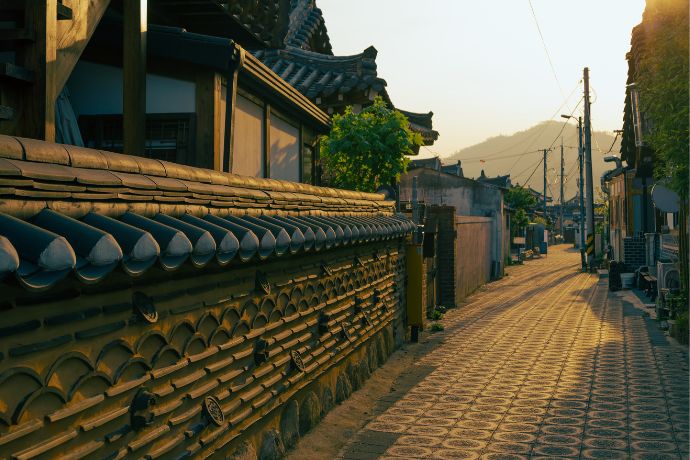
Five Silla Royal Tombs (Oreung)
This site is located a 15 minute bus trip south from the Daereungwon Tomb Complex. Oreung is the location of the Five Royal Tombs of the Silla Kingdom, which includes four kings and one queen. King Hyeokgeose was the founder and First King of the Silla Kingdom in approximately 57 BCE, along with this wife Queen Aryeong. King Namhae, King Yuri, and King Jabi also have tombs at this site. Also on site is the Sungdeokjeon Shrine which holds the ancestral tablet of King Park Hyeokgeose. The Aryeongjeong Well is purported to be the birthplace of Queen Aryeong.
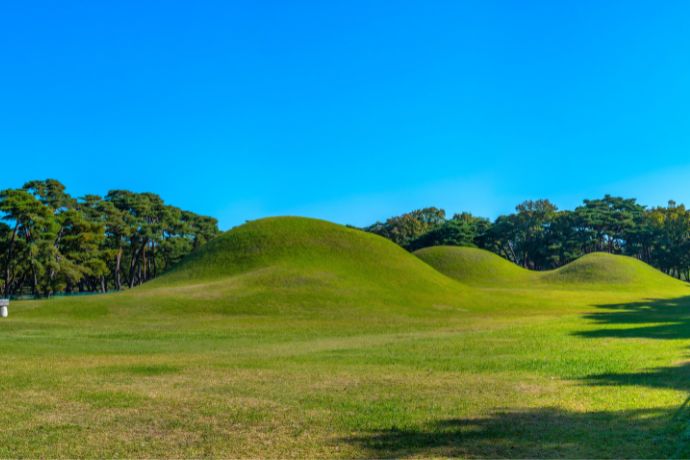
Tomb of Queen Seondeok
This site is located a 20 minute bus trip south east from the Daereungwon Tomb Complex. The Tomb of Queen Seondeok is a smaller attraction to see the main tomb. Click here to learn more about Queen Seondeok, the first Queen and 27th monarch of the Silla Kingdom.
Three Silla Royal Tombs (Samneung)
This site is located a 45 minute bus trip south from the Daereungwon Tomb Complex. On this site you can see the three royal tombs of King Adala (8th King), King Sindeok (53rd King) and King Gyeongmyeong (54th King).
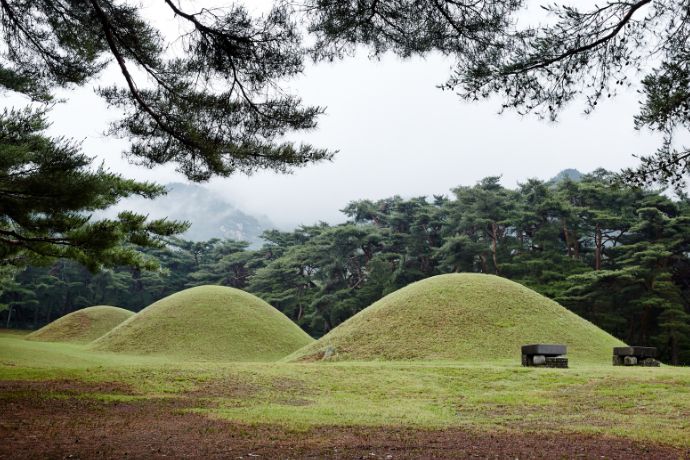
Attractions South from Gyeongju
Bulguksa Temple
Bulguksa Temple is an amazing Buddhist temple which is a UNESCO World Heritage Site originally built in approximately 774 AD. The Bulguksa Temple complex represents the paradise of Buddhist belief. After being destroyed several times during its history, since the 1970’s Bulguksa Temple has been partially restored, and is now home to many National Treasures of Korea.
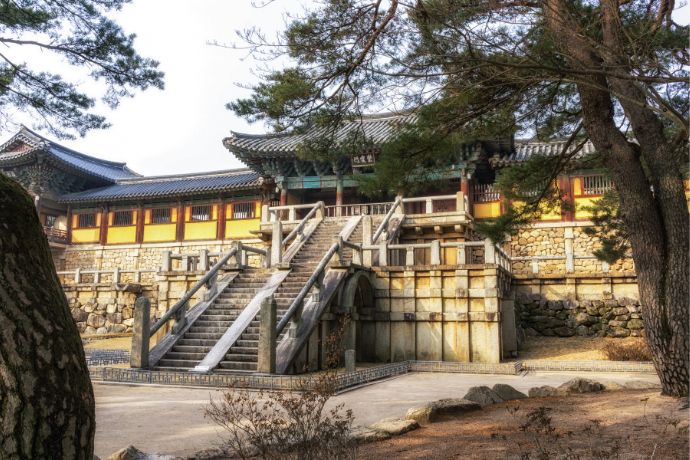
Plan to spend 1-2 hours exploring the temple complex. Bulguksa Temple is located a 1:10 hour bus trip south east from the Gyeongju Express Bus Terminal.
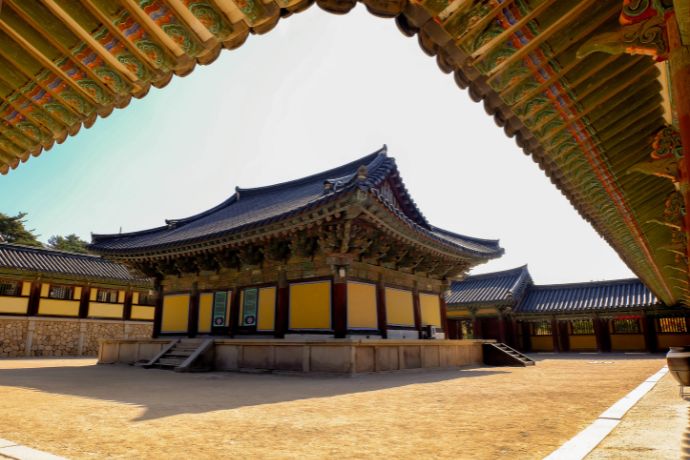
Seokguram Grotto
The Seokguram Grotto is located in the hills behind the Bulguksa Temple, where you can see the large seated Buddha carved from white granite inside the man made Buddhist cave temple which was created in approximately 751 AD. The Seokguram Grotto is part of the Bulguksa Temple complex, and is also a National Treasure of the Republic of Korea and is classified as a UNESCO World Heritage Site.
Seokguram Grotto is one of the furthest attractions from Gyeongju. You can get there by using two buses, a total trip of 1:30 hrs. You change buses at Bulguksa Temple, so I suggest you plan to visit the Seokguram Grotto first, then catch the bus back to explore Bulguksa Temple. Once you arrive in the car park you then do a pleasant 600m walk through the forest to get to the Seokguram Grotto. When you go inside you can look through the glass to see the amazing seated Buddha and artwork in the cave temple, however you are not permitted to take any photos.
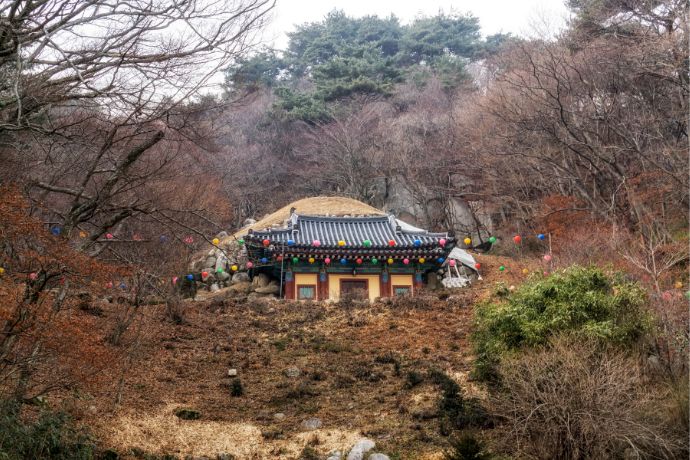
Gyeongju National Park
Gyeongju National Park is very large with eight separate districts spread Gyeongju. The park has both natural and historic features, including over 100 temples and stone Buddha statues. There are many hiking courses to explore the area which are detailed on the National Park website, where you can download a detailed guide to the National Park.
Gyeongju World Amusement Park
If you want to take a break from the history of Gyeongju then plan to visit Gyeongju World Amusement Park. During the warmer part of the year it is a fun theme park with rollercoasters, and over 30 rides plus fun activities for families with smaller children, plus a water play park. In winter the park transforms into a winter wonderland with snow tubing. You can visit for a few hours or all day! Gyeongju World Amusement Park is easily accessible by a 45 minute bus trip east from the Gyeongju Express Bus Terminal
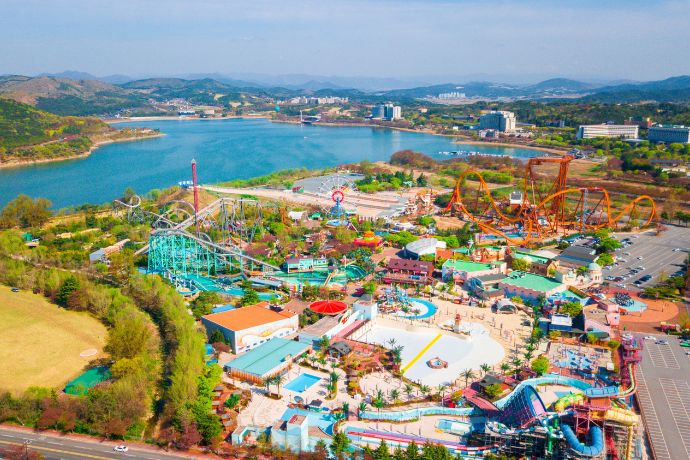
Gyeongju World Culture Expo Park
Gyeongju World Culture Expo Park is a separate attraction over the road from Gyeongju World Amusement Park. Its main feature is the 82m high Gyeongju Tower, which has built in the shape of a nine-story wooden pagoda of Hwangnyongsa Temple. The original pagoda was built during the reign of Queen Seondeok, and is believed to be the highest wooden structure in the world at the time. Inside the park you will find many historical and cultural displays. Plan 2-3 hours for your visit. Gyeongju World Culture Expo Park is easily accessible by a 45 minute bus trip east from the Gyeongju Express Bus Terminal

Golgulsa TempleStay
Golgulsa Temple is one of the most popular TempleStays in South Korea, where you can experience traditional rituals, meditation and martial arts training. Golgulsa has the only cave based temple in South Korea, and has a seated Buddha at the top of a long flight of stairs.
Golgulsa Temple is easy to access from the Gyeongju Express Bus Terminal. Bus number 100 / 100-1 / 150 all travel to Golgulsa, a trip of approximately 50 minutes, followed by a 15 minute walk.
Templestay options include the following options. Note that you need to scroll down to the bottom of the page at this link to see all of the available options.
- Daytime half day visit, which includes archery, meditation, watching a Sunmudo martial arts demonstration, Sunmudo training, 108 prostrations and dinner. This option is also suitable for families.
- Short and long term relaxation stays, which have a wellness focus through Seon meditation practice and Sunmodo martial arts training.
- Experience stays are available for one to three nights where you can experience Sunmudo martial arts and experience temple culture. This option is suitable for families.
- Special Weekend TempleStay programs which include trekking and meditation near the beach or mountains.
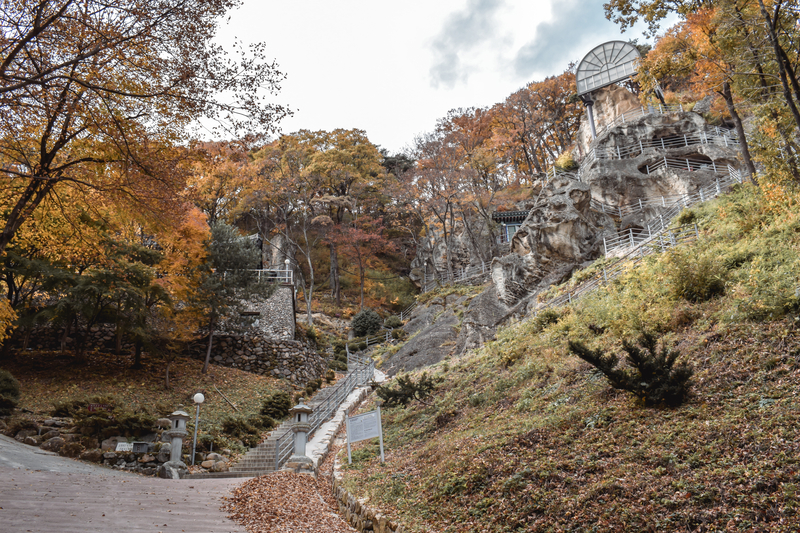
Attractions North from Gyeongju
Yangdong Folk Village
Yangdong Folk Village is Korea’s largest traditional village and has been designated as a UNESCO World Heritage Site, in conjunction with Hahoe Village in Andong. In Yangdong Village there are approximately 160 Josean style homes with both thatched and tiled roofs. Many of these homes are over 200 years old and as much as 500 years old and well preserved so you can get a sense of the era.
There are several walking routes to visit the village, taking anywhere from 20 minutes to one hour with many hills! Note that English signage is limited. Yangdong Folk Village is located a 1:30 hour trip north from Gyeongju Express Bus Terminal.
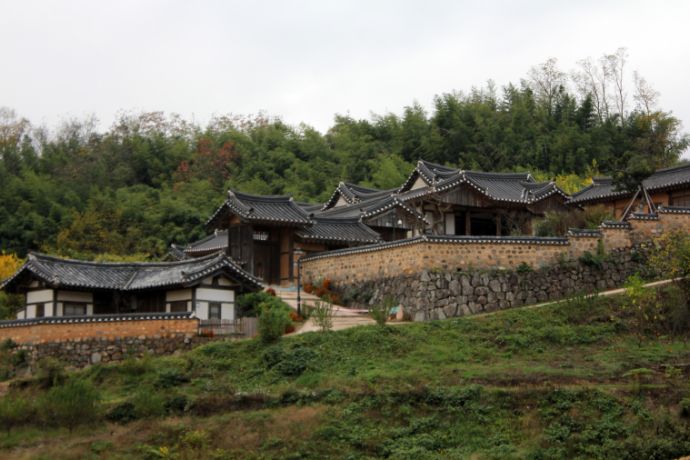
Gyeongju Tours
There are many Gyeongju day tour and experience options available through Trazy as detailed below:
- The Gyeongju 1 Day Bus Tour enables you to more easily visit the major attractions. There are three courses, which each run on different days with pick ups and drop offs from local hotels, the Express Bus Terminal and the Singyeongju KTX Station. Note that entrance fees are not included in the tour cost, and this tour is transport only, with a Korean tour guide (no English). Click here to check out and book these tours through Trazy.
- The Gyeongju Private Taxi Tour is a great option for small groups of up to 4 people to visit Gyeongju with a personalised itinerary and a driver with basic English. You will be picked up and dropped off at either your hotel, Express Bus Terminal or the Singyeongju KTX Station. Note that entrance fees are not included. Click here to check out and book this tour through Trazy.
- The Gyeongju Private One Day Tour is a great option for groups of up to 7 people to visit Gyeongju, either locally or from Busan, with a personalised itinerary and a driver with excellent English. You will be picked up and dropped off at either your Gyeongju or Busan hotel, Gyeongju Express Bus Terminal or the Singyeongju KTX Station. Note that entrance fees are not included. Click here to check out and book this tour through Trazy.
Gyeongju Tours from Busan
To visit Gyeongju as a day trip from Busan, the best option is to book a one day tour to make the most of your visit. There are several day tour options available through Klook as follows:
- Visit Yangdong Village, Anapji Pond, Bulguksa Temple and the Seokguram Grotto. This tour is available on Thursday each week. Pick up and drop off from KTX Busan Station, Seomyeon Station and Haeundae Station. Click here to check out and book this tour through Klook.
- Visit Cheomseongdae Observatory, Daereungwon Tomb Complex, Hwanglidan Street, Gyochon Traditional Village, Woljeong Bridge, Bulguksa Temple and Night view of Anapji Pond. This small group tour is available on Tuesday and Friday each week. Pick up and drop off from Seomyeon Station or Ulsan KTX Station. Click here to check out and book this tour through Klook.
- Visit Bulguksa Temple, Seokguram Grotto, Anapji Pond, Cheomseongdae Observatory, Gyeongju National Museum, Cheonmachong Tomb and Yangdong Folk Village. This private tour (up to 8 passengers) is available every day and will pick up and drop off at your Busan hotel. Click here to check out and book this tour through Klook.
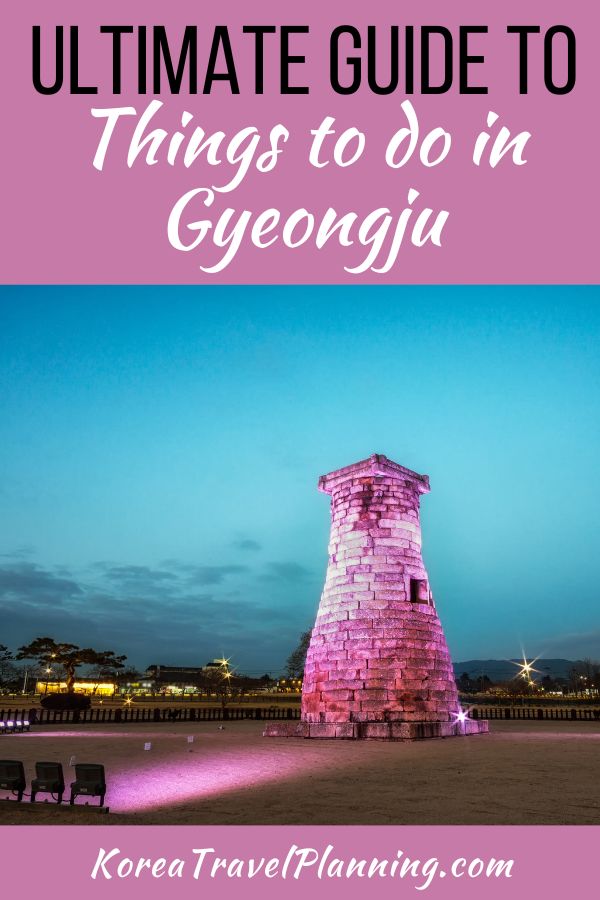
Join the South Korea Travel Planning Facebook Group
You are also welcome to join our South Korea Travel Planning Facebook Group – it is a great resource to enable you to ask questions about your upcoming trip to South Korea!
Disclaimer: This article contains affiliate links. If you book after clicking on one of these links then we may receive a small commission at no extra cost to you.
Anne Sutherland-Smith is a seasoned travel writer and a passionate explorer of South Korea’s vibrant culture, history, and landscapes. With decades of travel experience, Anne deeply understands what makes Korea a unique and captivating destination for travelers worldwide. As the lead author for koreatravelplanning.com, Anne’s work is based on thorough research and firsthand experiences. Her insights are regularly sought after in the travel community, and she has been featured in various travel forums and publications. Her expertise extends to Korean destinations, transportation, cuisine and the latest trends in Seoul’s bustling city life.
Dedicated to providing reliable and practical travel advice, Anne ensures that every piece of content on koreatravelplanning.com is accurate, up-to-date, and useful for travelers at every stage of their journey. Her commitment to authenticity and her personal experiences traveling across Korea make her a trusted voice in the travel community.
Follow Anne’s adventures and get valuable Korea travel tips on koreatravelplanning.com and through her social media channels. Whether you’re planning your first trip to Korea or looking to explore deeper, Anne’s insights will be your invaluable guide.


